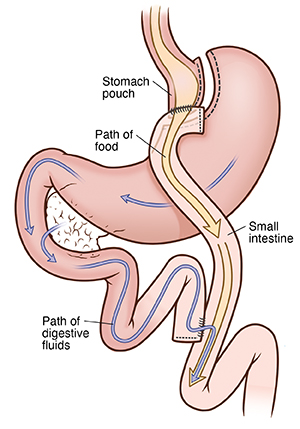Bariatric Surgery: Roux-en-Y Gastric Bypass
Bariatric surgery is a procedure that helps you lose weight. It can change the size of your stomach and the length of your small intestine that comes in contact with the food you eat. The goal is to limit how much food can be eaten and absorbed at one time. Bariatric surgery can be done in several ways. You are having a Roux-en-Y gastric bypass (RYGB). This is one of the most common types of bariatric surgeries. During this type of procedure, part of the stomach is separated from the rest of the stomach. It's closed off with staples to create a smaller pouch. The smaller stomach helps restrict the amount of food you can eat at one time. The small intestine is then divided. Part of it is reattached to the stomach pouch. Because some of the small intestine is bypassed, less food is absorbed as well. This surgery can be done by open incision, laparoscopic, or robotic methods.
The procedure
A large part of the stomach is closed off. This leaves a small pouch to hold food, limiting the amount that can be eaten at one time. The small intestine is cut below the duodenum and reattached to the new stomach pouch. This leaves a shortened path for food to travel through. As a result, some of the food that's eaten leaves the body as waste. It's not absorbed as energy. The remaining pouch of the stomach and duodenum are also reattached to the small intestine farther down. This is done to drain stomach, biliary and pancreatic enzymes, and fluids.

Possible gallstones
Bariatric surgery is designed to cause a large amount of weight loss. Rapid weight loss can cause deposits in the gallbladder called gallstones. The gallbladder may need to be removed at a later date. If you already have gallstones, the gallbladder may be removed at the time of your RYGB operation.
All types of bariatric surgery have different advantages and disadvantages. Be sure to discuss the risks and complications of this surgery, and any alternatives with your healthcare provider.